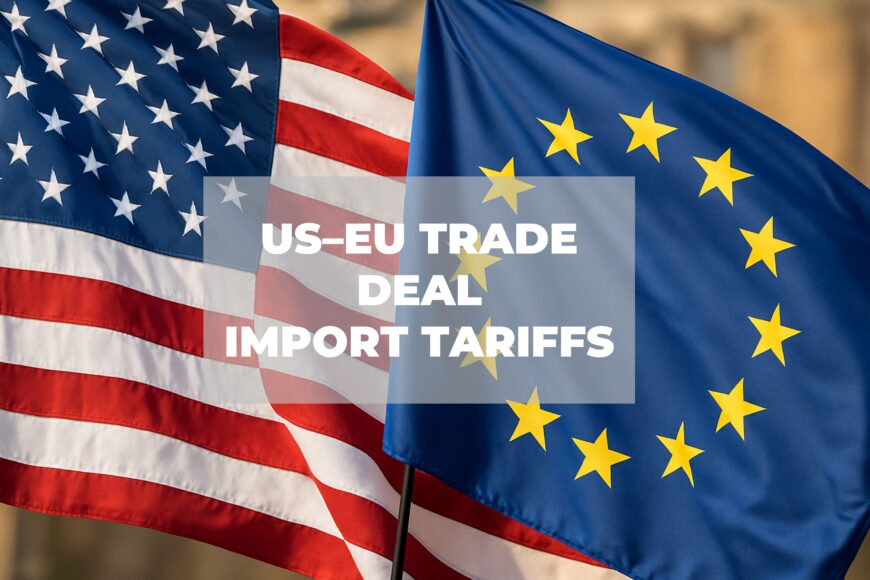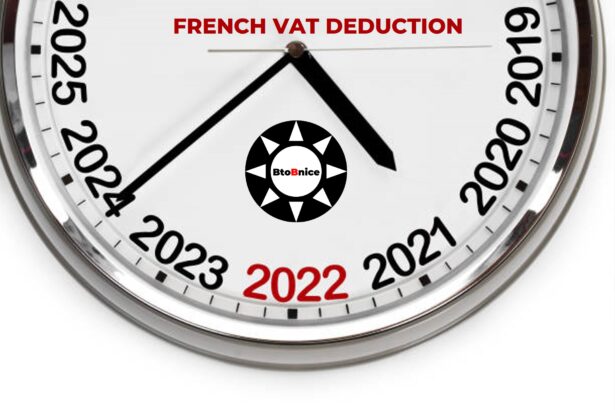New US – EU Trade Deal: Tariffs On Transatlantic Exports

On Sunday, July 27, U.S. President Donald Trump and European Commission President Ursula von der Leyen concluded a high-stakes transatlantic trade deal at Trump’s Turnberry resort in Scotland. The agreement sets a 15% tariff on most EU exports to the U.S., narrowly averting a 30% tariff hike Trump had threatened by his August 1 deadline. In return, the EU committed to significant economic concessions, including major purchases and investments in the U.S. economy.
Agreed U.S. tariffs on EU exports
The below US tariffs should apply starting from August 2025 on goods imported from the 27 EU member states:
- 15% flat rate on most EU goods
This includes automobiles, semiconductors, pharmaceuticals, agricultural goods, and machinery
- 50% tariffs on steel & aluminium
The U.S. will maintain 50% tariffs on EU exports of steel and aluminium for now; a future quota or reduction may follow.
- Zero-for-zero exemptions on strategic goods
The tariffs’ exemption concerns all aircraft and components, select chemicals, generic drugs, semiconductor equipment, some agricultural products, critical raw materials and natural resources.
Wine and spirits, along with some other sensitive sectors, are still under negotiation and may be added to the exemption list in the coming weeks.
EU’s counterpart obligations
As conditions of the deal, the EU undertook:
- $750 billion in additional purchases of U.S. energy products over the next 3 years, including LNG, oil, and nuclear fuels
- $600 billion in new EU investment in the U.S., beyond existing levels, directed at pharma, automotive, infrastructure
- Military acquisitions of U.S. defense equipment, though dollar amounts remain less specified
The EU also committed to better access for American exports to its internal market, including lower regulatory barriers and future discussions on non-tariff cooperation.
Historical context: how Trump secured this deal
- Before 2025, average U.S. tariffs on EU goods hovered around 2.2%, with 2.5% for cars. European tariffs averaged 2.7%.
- In April 2025, Trump launched a global tariff hike, setting 25% on cars, and 50% on steel and aluminium, justifying the move on national security and reciprocity based on the EU Value Added Tax on imported goods.
- In May 2025, he escalated tensions, announcing a 50% tariff on nearly all EU goods. This was later reduced to 30%, with a hard August 1 deadline.
- After weeks of shuttle diplomacy, the EU accepted a 15% compromise.
Several deals were finalised earlier this year:
- UK: Trump had previously applied a 10% tariff to British goods, a point of comparison highlighting the relative severity of the EU outcome.
- Japan: 15% tariff on Japanese exports, as part of a deal similar in structure
- Vietnam, Indonesia, Philippines: Deals ranging around 19–20% tariffs
Next steps: finality and approval process
On the U.S. side, the tariff structure will be enacted via executive orders, expected by the end of July.
On the EU side, the European Commission has the mandate to proceed but is seeking broad consensus among member states to politically validate the deal. EU legal instruments to implement reciprocal tariff changes will take about one week or more to finalise.
Sector-specific details (e.g. for wine and spirits, digital products) may still evolve through bilateral technical talks.
Immediate consequences for European businesses
- Increased import costs into the U.S.: EU Exporters of non-exempted goods must now factor in a 15% duty.
- Compliance and origin strategy becomes crucial: For products in exempt categories, clear documentation and classification will be essential to benefit from zero tariffs.
- Uncertainty in metals sector: With steel and aluminium still at 50%, affected EU groups will need to re‑source suppliers or absorb costs.
- Transfer pricing and contract renegotiation: Businesses should review pricing policies and intercompany agreements impacted by margin compression due to tariffs.
- Supply chain realignment: Companies may reconsider U.S. manufacturing or warehousing to reduce exposure to border duties.
- Legal exposure: Trump retains the right to reimpose higher tariffs if EU investment commitments fall short, making long-term planning more uncertain.
EU Source: Statement by President von der Leyen on the deal on tariffs and trade with the United States



